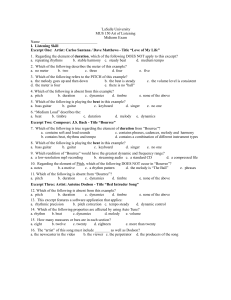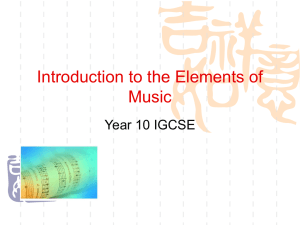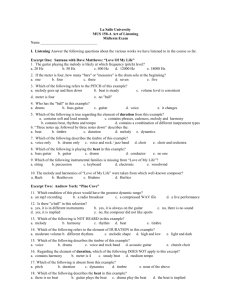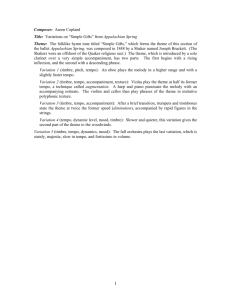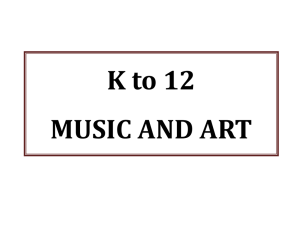La Salle University MUS 150-A Art of Listening Midterm Exam Name
advertisement
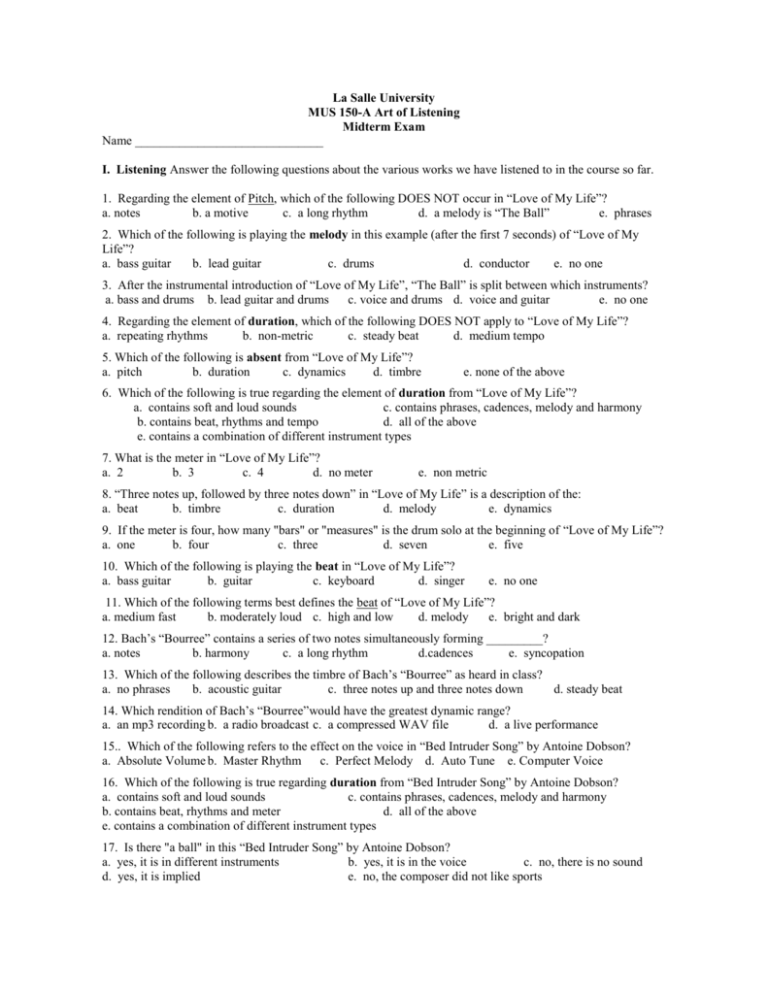
La Salle University MUS 150-A Art of Listening Midterm Exam Name ______________________________ I. Listening Answer the following questions about the various works we have listened to in the course so far. 1. Regarding the element of Pitch, which of the following DOES NOT occur in “Love of My Life”? a. notes b. a motive c. a long rhythm d. a melody is “The Ball” e. phrases 2. Which of the following is playing the melody in this example (after the first 7 seconds) of “Love of My Life”? a. bass guitar b. lead guitar c. drums d. conductor e. no one 3. After the instrumental introduction of “Love of My Life”, “The Ball” is split between which instruments? a. bass and drums b. lead guitar and drums c. voice and drums d. voice and guitar e. no one 4. Regarding the element of duration, which of the following DOES NOT apply to “Love of My Life”? a. repeating rhythms b. non-metric c. steady beat d. medium tempo 5. Which of the following is absent from “Love of My Life”? a. pitch b. duration c. dynamics d. timbre e. none of the above 6. Which of the following is true regarding the element of duration from “Love of My Life”? a. contains soft and loud sounds c. contains phrases, cadences, melody and harmony b. contains beat, rhythms and tempo d. all of the above e. contains a combination of different instrument types 7. What is the meter in “Love of My Life”? a. 2 b. 3 c. 4 d. no meter e. non metric 8. “Three notes up, followed by three notes down” in “Love of My Life” is a description of the: a. beat b. timbre c. duration d. melody e. dynamics 9. If the meter is four, how many "bars" or "measures" is the drum solo at the beginning of “Love of My Life”? a. one b. four c. three d. seven e. five 10. Which of the following is playing the beat in “Love of My Life”? a. bass guitar b. guitar c. keyboard d. singer e. no one 11. Which of the following terms best defines the beat of “Love of My Life”? a. medium fast b. moderately loud c. high and low d. melody e. bright and dark 12. Bach’s “Bourree” contains a series of two notes simultaneously forming _________? a. notes b. harmony c. a long rhythm d.cadences e. syncopation 13. Which of the following describes the timbre of Bach’s “Bourree” as heard in class? a. no phrases b. acoustic guitar c. three notes up and three notes down d. steady beat 14. Which rendition of Bach’s “Bourree”would have the greatest dynamic range? a. an mp3 recording b. a radio broadcast c. a compressed WAV file d. a live performance 15.. Which of the following refers to the effect on the voice in “Bed Intruder Song” by Antoine Dobson? a. Absolute Volume b. Master Rhythm c. Perfect Melody d. Auto Tune e. Computer Voice 16. Which of the following is true regarding duration from “Bed Intruder Song” by Antoine Dobson? a. contains soft and loud sounds c. contains phrases, cadences, melody and harmony b. contains beat, rhythms and meter d. all of the above e. contains a combination of different instrument types 17. Is there "a ball" in this “Bed Intruder Song” by Antoine Dobson? a. yes, it is in different instruments b. yes, it is in the voice c. no, there is no sound d. yes, it is implied e. no, the composer did not like sports II. Multiple Choice – Music Terminology 18. The Energy of a piece of music, including the beats and rhythms is referred to as the: a. beat b. melody c. cadence d. repeat e. groove 19. Which of the following is a measurement of cycles to determine pitch? a. mp3 b. Hertz c. Compression d. Beatz e. Tempo 20. Which of the following abbreviations refers to the timbre of a choral work? a. AABA b. EBGDF c. SATB d. forte e. form 21. Auto tune bends a ________ to an exact _________ a. note, pitch b. rhythm, beat c. dynamic, volume d. beat, meter e. timbre, frequency 22. The decibel level of an acoustic classical guitar is approximately: a. 20-60 dB b. 100 dB c. 150 dB d. 180 dB e. over 200 dB 23. What must be present in order for an ensemble to be considered an orchestra? a. brass b. each of the instrument families c. woodwinds d. bowed strings 24. A sudden dynamic change is called a ____________? a. subito b. prospero c. tempo d. soprano e. over 25 people e. burrito 25. In any piece of music, which timbre is always present? a. drums b. bass c. cymbals d. violin e. there is no requirement for a specific timbre 26 The term "decrescendo" means to gradually get: a. louder b. faster c. lower in pitch d. softer e. slower 27. Which of the following is NOT considered a "family" of instruments? a. Woodwind b. String c. Brass d. Violin e. Percussion 28. The _______ of a musical work is usually grouped in 2s, 3s OR 4s. a. interval b. pitch c. meter d. dynamics e. cadence 29. The steady underlying pulse that occurs in a piece of music is called the: a. beat b. pitch c. timbre d. dynamic e. conjunct interval 30. In jazz, one time through the song structure (ex. in a solo) is called a: a. resolution b. soprano c. chorus d. timbre e. subito 31. Which of the following is not specifically an element or property of music? a. duration b. harmony c. pitch d. dynamics e. timbre 32. Which of the following terms is a series of pitches played one at a time to form a logical idea? a. melody b. sound quality/tone color c. tempo d. chord e. harmony 33. In any piece of music, the beat will always be played by the: a. drums b. bass c. cymbals d. violins e. it might not be played at all 34 The term "crescendo" means to gradually get: a. louder b. faster c. higher in pitch d. softer e. slower 35. Which of the following is not required to fit our definition of music? a. time b. organization c. singing d. sound 36. Which of the following is the MOST COMMON voice type for a male? a. tenor b. baritone c. bass d. falsetto e. alto 37. The Loudness Wars have contributed to recorded music sounding: a. softer b. cleaner c. denser d. thinner e. all of the above 38. Which of the following is the highest voice type for a female? a. soprano b. contralto c. mezzo-piano d. mezzo-soprano e. alto 39. A shorter string length will produce a ____________ pitch than a longer string length. a. louder b. softer c. bigger d. higher e. closer 40. Which of the following is a description of the sounds you are hearing? a. duration b. harmony c. pitch d. dynamics e. timbre 41. Consonances and dissonances are descriptions between: a. beats b. instruments c. volumes d. harmonies e. people 42. In an orchestra, the specific bowings (up and down) for the violin section is decided by: a. conductor b. composer c. individual violinist d. concertmaster e. rock, paper, scissors 43. The words "long" and "short" refer to which of the following terms? a. pitch b. rhythm c. dynamics d. timbre e. motive 44. The words "loud" and "soft" refer to which of the following terms? a. pitch b. rhythm c. dynamics d. timbre e. tempo 45. The words "fast" and "slow" refer to which of the following terms? a. pitch b. motive c. dynamics d. timbre e. tempo 46. Which of the following families may be bowed or plucked? a. Woodwind b. String c. Percussion d. Keyboard e. Brass 47. A singer (and some instrumentalists) often incorporates _______ in pitch for expression. a. a snare drum b. new lyrics c. harmony d. vibrato e. a conductor 48. The file size of an mp3 version of a song is ________________ that of the original. a. the same as b. the same length as c. smaller than d. more muffled than e. softer than 49. The voice classification for a high male is: _______. a. soprano b. mezzo soprano c. contralto/alto d. baritone e. tenor 50. What is the primary consideration for placing a musical instrument into a family? a. how it produces sound b. what it is made of c. how it sounds d. what it looks like 51. Tempo is a term which refers to the ______________ a. melody b. dynamic level c. speed of the beats 52. A phrase usually ends with a(n): a. interval b. cadence c. melody d. sound of the instruments d. beat e. rhythm 53 The range of human hearing generally extends from _______________ Herz. a. 10 to 100 b. 20 to 200 c. 50 to 5,000 d. 100 to 10,000 54. Which of the following is the low voice type for a male? a. tenor b. baritone c. bass d. falsetto e. composer e. 20 to 20,000 e. alto 55. The voice classification for a low female is: _______. a. soprano b. mezzo soprano c. contralto/alto d. baritone e. tenor 56. A ______ is a resting place in music, and may be either temporary (incomplete) or permanent (complete). a. pitch b. cadence c. rhythm d. dynamic e. mezzo soprano 57. When the beat is not evident in a musical work, it is said to be: a. nonmetric b. fast c. inconclusive d. cadence 58. The most common meter in music is: a. one b. two c. three d. four e. accented e. music has no meter 59. Which of the following terms is “I’m lovin’ it” in the McDonald’s song in their commercials? a. meter b. timbre c. tempo d. motive e. beat 60. When you answer your phone without resorting to Caller ID, your can tell who you are talking to by which of the elements of music/sound? a. duration b. pitch c. dynamics d. timbre e. wouldn’t answer without Caller ID 61. Which of the following is NOT associated with the Duration element of music? a. downbeat b. syncopation c. tempo d. meter e. voice 62. In most pieces of music, if the beat is not heard, it is _______________. a. implied b. absent c. too fast d. too soft e. too high 63. Which of the following instruments is not from the plucked string family? a. mandolin b. acoustic guitar c. banjo d. harmonica e. electric guitar III. Matching 64. _______ Consonance A. device to alter the TIMBRE of a recording 65. _______ Active listening B. Sudden change of dynamic level 66. _______ Melody C. Gradually getting louder 67. _______ Crescendo D. Italian word for “strong” or “loud” 68. _______ Equalizer E. Concentrating on what you hear 69. _______ Passive listening F. Subtle variations in pitch to enrich tone 70. _______ The “Ball” G. Stable sound found in harmony 71. _______ Piano H. Blending a pitch to the nearest exact note 72. _______ Tempo I. How the beats are grouped (usually 2, 3, or 4) 73. _______ Groove J. A pattern of shorts and longs 74. _______ Rhythm K. Italian term for medium or half 75. _______ Meter L. When the beat is not evident 76. _______ Auto Tune M. Energy of a piece of music, beats and rhythms 77. _______ Non-metric N. Italian word for “soft” 78. _______ Subito O. Hearing in the background 79. ______ Forte P. Prevalent part of a song at any given time 80. ______ Mezzo- Q. Speed of the beats 81. ______ Vibrato R. One pitch at a time; the “tune” Answer Sheet and Part IV Name _____________________________ 1 . _____ 23 . _____ 45 . _____ 67 . _____ 2 . _____ 24 . _____ 46 . _____ 68 . _____ 3 . _____ 25 . _____ 47 . _____ 69 . _____ 4 . _____ 26 . _____ 48 . _____ 70 . _____ 5 . _____ 27 . _____ 49 . _____ 71 . _____ 6 . _____ 28 . _____ 50 . _____ 72 . _____ 7 . _____ 29 . _____ 51 . _____ 73 . _____ 8 . _____ 30 . _____ 52 . _____ 74 . _____ 9 . _____ 31 . _____ 53 . _____ 75 . _____ 10 . _____ 32 . _____ 54 . _____ 76 . _____ 11 . _____ 33 . _____ 55 . _____ 77 . _____ 12 . _____ 34 . _____ 56 . _____ 78 . _____ 13 . _____ 35 . _____ 57 . _____ 79 . _____ 14 . _____ 36 . _____ 58 . _____ 80. . _____ 15 . _____ 37 . _____ 59 . _____ 81. . _____ 16 . _____ 38 . _____ 60 . _____ 17 . _____ 39 . _____ 61 . _____ 18 . _____ 40 . _____ 62 . _____ 19 . _____ 41 . _____ 63 . _____ 20 . _____ 42 . _____ 64 . _____ 21 . _____ 43 . _____ 65 . _____ 22 . _____ 44 . _____ 66 . _____ IV. True or False. For each statement, indicate if it is true or false. *BONUS - change each false statement to make it read true. 82. ____ When a soloist is improvising in jazz, there is no attention paid to the harmony or form of the tune. 83. ____ The timbre of a work may be described as loud or soft, fast or slow. 84. ____ The shorter the vibrating element in an instrument, the higher the pitch. 85. ____ A crescendo is an arrival point or climax. 86. ____ Beethoven actually composed the song “Love of My Life”. 87. ____ If your voice type is a soprano, you can work very hard and become an alto. 88. ____ In any selection of music, once an instrument has “the Ball”, they will have it until the end. 89. ___ The Piano is the correct, full name of the large white instrument in our classroom. 90 ____ The softest instruments are placed at the front of the orchestra. 91. ____ When you hear a piece of music, timbre might not necessarily be present. 92. ____ The form of “Take the A Train” is BABA. 93. ____ The tune of a jazz composition played at the beginning and end is called the “tail”. 94. ____ Jazz in a style of music for instruments only, not voices. 95. ____ Humans are unable to hear frequencies below 1,000 Hz. 96. ____ Compression is used in audio recordings to reduce the dynamic range. 97. ____ The Loudness Wars are an imaginary concept to describe how concerts are getting louder. 98. ____ The Italian word for soft is piano. 99. ____ A sudden change in dynamic level is called a motive. 100. ___ Mezzo- means “full” or “heavy”. V.**BONUS** For every question you answer, provide as much detail as you are able. Each correct “point” you make in your discussion will result in an extra credit “point” being applied to your final score. Feel free to make your answers in essay or list form. You may use additional pages if necessary! 1. Describe how the elements of music are most commonly used in everyday popular music. 2. Describe the typical seating plan of an orchestra. 3. List an example of each family of musical instruments, and describe its timbre in your own words. 4. Describe how am mp3 file format compares to CD-quality audio. 5. Discuss the Loudness Wars.


